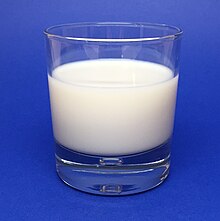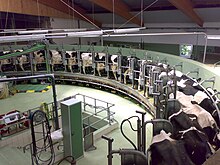**1. Milk Production and Consumption:**
– India was the largest milk producer in 2012.
– European Union members produced the most milk in 2013.
– Developing countries have seen a rise in milk consumption.
– Multinational dairy firms have invested in growing markets.
– Milk production remains small scale in many countries.
– Israel dairy farms are the most productive globally, yielding 12,546kg (27,659lb) milk per cow annually.
– Average herd size in developed countries increased from 74 to 99 cows per herd between 2001 and 2007.
– New Zealand had an average of 19 cows per herd, while in Norway it was 337.
– Annual milk production per cow in developed countries rose from 7,726 to 8,550kg (17,033 to 18,850lb) between 2001 and 2007.
– Factors affecting milk yield include production systems, cow nutrition, and genetic potential.
**2. Milk Composition:**
– Butterfat in milk consists of fatty acids like myristic, palmitic, and oleic acids.
– Milk is an emulsion of butterfat globules in a water-based fluid containing carbohydrates, proteins, and minerals.
– Milk provides essential nutrients for growth, including energy, amino acids, vitamins, and water.
– Milk composition varies due to genetic, lactational, and nutritional factors.
– Fat globules in milk vary in size and contain fat-soluble vitamins and essential fatty acids.
– Cow’s milk pH ranges from 6.7 to 6.9, similar to other mammals.
– Milk salts interact strongly with casein, particularly calcium phosphate.
– Vitamins A, B6, B12, C, D, K, E, thiamine, niacin, biotin, riboflavin, folates, and pantothenic acid are found in milk.
**3. Milk Processing and Safety:**
– Pasteurization kills harmful bacteria like M. paratuberculosis and E. coli by heating and cooling milk.
– Types of pasteurized milk include full cream, reduced fat, skim milk, and flavored varieties.
– Standard pasteurization process ensures milk safety for up to three weeks if refrigerated.
– Heating during pasteurization leads to minor losses in vitamin and mineral content.
– Microfiltration reduces microorganisms in milk without altering taste.
– Ultrafiltration retains fats, calcium, and protein while allowing lactose and water to pass through.
– Fresh milk separates into cream and milk layers upon standing.
– Homogenization prevents cream separation by breaking up fat globules.
– Homogenized milk has a more uniform fat distribution.
**4. Historical and Cultural Aspects of Milk:**
– Humans started consuming milk after domesticating animals.
– Dairy animals were first domesticated in Southwest Asia.
– Dairying began in the early phases of agriculture.
– Domestic dairy animals spread to Europe and South Asia.
– Pastoral economies developed as farmers moved into new regions.
– Egyptian records mention burn dressings with milk.
– Milk consumption in various regions increased due to colonialism.
– Milk was considered a safe alternative to water in the Middle Ages.
– Misconceptions about milk being white blood existed.
– Nut milk has been made historically by tribes in northern woodlands.
**5. Other Animal-Based Sources of Milk:**
– Goats and buffaloes are significant milk sources.
– Various animals provide milk for human consumption.
– Moose dairies exist in Russia and Sweden.
– American bison are not commercially milked.
– Swine milk is not commonly used for human consumption.
Milk is a white liquid food produced by the mammary glands of mammals and the caecilian Siphonops annulatus. It is the primary source of nutrition for young mammals (including breastfed human infants) before they are able to digest solid food. Immune factors and immune-modulating components in milk contribute to milk immunity. Early-lactation milk, which is called colostrum, contains antibodies that strengthen the immune system and thus reduce the risk of many diseases. Milk contains many nutrients, including protein and lactose.


As an agricultural product, dairy milk is collected from farm animals. In 2011, dairy farms produced around 730 million tonnes (800 million short tons) of milk from 260 million dairy cows. India is the world's largest producer of milk and the leading exporter of skimmed milk powder, but it exports few other milk products. Because there is an ever-increasing demand for dairy products in India, it could eventually become a net importer of dairy products. New Zealand, Germany, and the Netherlands are the largest exporters of milk products. The US Centers for Disease Control and Prevention recommends that children over the age of 12 months should have two servings of dairy milk products a day.
More than six billion people worldwide consume milk and milk products, and between 750 and 900 million people live in dairy-farming households.
